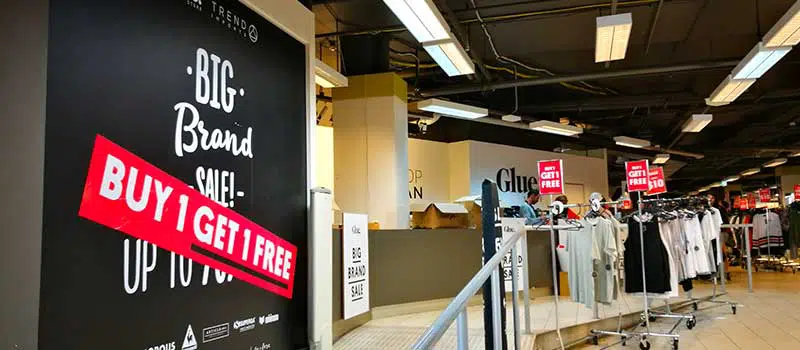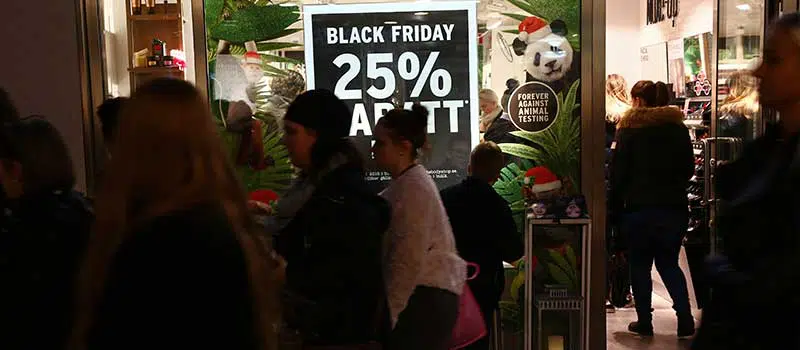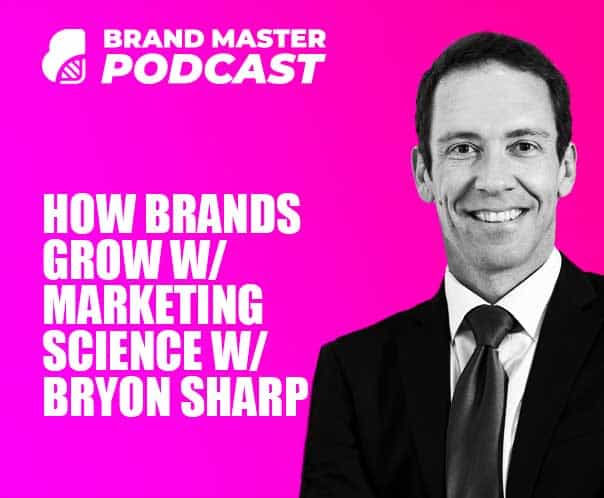We’ve all been there…
We see a product on promotion and we see an opportunity.
Maybe you’ve been thinking of this particular product for a while or maybe it’s new to you.
Either way, the reduced price and perceived value pull you in.
It’s an easy decision…
“Look at what the value is and look at what I can get it for. It’s a no-brainer.”
And just like that, you’re pulling out your credit card and making that buying decision.
But why is promotional pricing so effective, and how and when should and shouldn’t you use this strategy?
That’s exactly what you’ll learn in this article (along with some top examples, of course).
What is Promotional Pricing?

Let’s start with the definition of Promotional Pricing.
Promotional pricing is a pricing strategy used by brands that want to drive sales in the short-term. They do this by temporarily reducing the price of products or services to entice customers to buy before the offer expires, often through integrated marketing campaigns.
Without a doubt, promotional pricing is one of the most effective strategies for driving short-term sales.

Brands that leverage it effectively can expect to see revenue growth for the period of the promotion.
Although promotions tend to be associated with retailers, they are also used frequently by restaurants, gyms, airlines and service providers to name a few.
Essentially any brand that wants to drive more sales in the short term can leverage the promotional pricing strategy.
The Promotional Pricing Goal

The goal of promotional pricing is to drive more sales and revenue in a short time to boost the immediate revenue and the bottom line for the quarter or year.
Often this approach is used as part of a longer-term strategy and not as a standalone approach to pricing products and services.
Promotional pricing is without a doubt, a highly effective strategy for driving more sales. However, its effectiveness over time depreciates.
Brands that use promotional pricing need to be aware of the pros and cons, which we’ll cover a little later.
PRO Brand Strategy BluePrint
Build Brands Like A Pro Brand Strategist

Promotional Pricing Pros & Cons

Every tactic in every strategy, from branding to football, needs consideration.
If you were to make a strategic decision on promotional pricing in a silo, it would be easy to assume that if it’s effective and it drives sales, then it’s a no-brainer. But there are bigger implications at play.
Let’s take a closer look at some of the advantages and disadvantages of Promotional Pricing.
Explore Brand Strategy
Programs & Tools
Advantages Of Promotional Pricing

Here are some of the most compelling reasons to use promotional pricing as part of your pricing strategy.
Increase In Sales & Revenue

The most obvious advantage of running sales promotions is the injection of sales and ultimately cash into the business.
Whether the additional revenue is helping to pay the bills or boosting the profits on an already impressive year, revenue & profits are the lifeblood of any successful business.
Enter your text here...
Urgency Drives Action

The law of scarcity detailed by Robert Chialdini in his ground-breaking book “Influence: The Psychology Of Persuasion” is the fear of missing out.
The nature of price promotions is that they’re time-bound so they are inherently scarce.
A promotion pricing strategy that’s not timebound won’t have anywhere near the impact of one that is. You want your discounted price to be limited so it incentivizes customers by creating a sense of urgency. Nobody wants to miss out on seasonal sales, for example.
Driven by the fear of missing out, buyers are driven to take action now, to lock in the value on offer before it’s gone.
Value Perception Favours The Buyer

When we go shopping for something, consciously or subconsciously, we want to see some value.
This is why discounted buys on higher volumes work well even though the price is higher. It lowers the average cost per item, increasing the value for the buyer.
Even wealthy shoppers with no restraints looking towards the top shelves, don’t want to be taken over the coals.
In other words, in one way or another, we’re all drawn to value. And promotional pricing leans value in favour of the buyer, increasing the willingness to purchase.
Advantage Over Competition

When it comes to products in direct competition with each other, pricing promotions offer discounted products a competitive advantage.
All things being equal, we’re more likely to buy an identical product that’s discounted, than one at full price.
Even if this competitive advantage is short-lived, it can impact the sales and revenue of the brand on promotion and its competitors. It can also turn an otherwise reluctant audience into loyal customers in the long run.
Greater Volumes, Greater Buying Power

Brands that understand their price promotion strategy in great detail through extensive research can predict with a certain degree of accuracy, the likely impact on sales volumes.
This puts more power into the hands of the business, allowing them to source materials in higher volumes and at lower prices, ultimately reducing their cost of production per unit and improving profit margins.
Of course, this is off-set with the reduction in price-per unit though the life-time value of a new customer may make this a valuable trade-off to the business.
Disadvantages Of Promotional Pricing

As always, with any strategic decision, we must consider the disadvantages of a given strategy or tactic.
When it comes branding and pricing promotions, there are a few important disadvantages to consider.
Brand Perception & Loyalty

The most important factor to consider when determining the price of a product is the impact it has on the brand’s perception in the market as well as customer loyalty.
Brands that operate with regular price promotions can negatively impact the relationship with customers on both ends of the price scale.
Customers who purchase the brand’s products at full price may very well feel cheated when they see the same products on offer at a discounted rate.
On the other hand, the shopper at the low price point may feel disgruntled when they want to make a repeat purchase only to see that the price has gone up.
Both sets of customers will likely feel less loyalty towards the brand affecting the brand’s overall perception in the market. In the long term, this can decrease customer traffic and reduce the brands’s market share.
Price Perception & Cannibalisation

Brands leveraging the price promotions regularly are sending a consistent message to their audience and the audience listens.
The message they send is:
We’ll will be back with another promotion soon.
Repeated discounts and promotions affect the price perception of the brand’s products, impacting sales outside the promotional period. And even if the sales run for a limited time, having consumers get used to frequent discounts removes the sense of urgency — they can get whatever it is at the next sale.
We see this a lot with e-commerce businesses and consumers waiting for holiday promos to get their shopping done.
In other words, customers become trained to wait for the promotions rather than pay the regular price outside the promotion.
Price Wars

Price wars are a well-documented side-effect of price promotions in highly competitive marketplaces.
As we covered earlier, discounts offer brands a short-term competitive advantage which may result in the competition responding with their own, lower discount.
When brands go toe-to-toe on price promotions, it can quickly become a price war which impacts the profits of not just the brands at war, but the entire industry.
In price wars, there is only one winner… the customer.
The Psychology of Price Promotions

As I covered earlier, there’s a lot going on in the mind of the customer when it comes to price promotions.
For the most part, much of this happens on a subconscious level.
Value Perception
Price Perception
Brand Perception
Brand Loyalty
The Fear Of Missing Out
The Gratification Of Purchase Success
Promotion Expectation
Promotion Addiction
All of these factors are at play during a pricing promotion, and brands operating with this approach as part of an overall strategy need to consider both the long-term and short-term effects.
Promotional Pricing Examples & Types

With all that being said, let’s take a look at some of the most widely used promotional pricing examples so you can see if there’s a certain type of promotion that will work well for you.
Sale Price

This is probably the most well-recognised vanilla pricing strategy approach.
A simple sale offering the buyer a sale by a dollar value or a percentage value. For example, 25% off or $25 off.
The impact of either of these approaches is relative to the original price. For example, $25 off a $900 product is far less appealing than 25% off.
Two For One

The buy-one-get-one-free model can be used in a few different ways.
The most obvious gives the buyer a second item for the original price. For example, two tubes of toothpaste for one.
But it can also be used to incentivise couples or parents to pay for experiences or entertainment such as two cinema tickets for the price of one or two meals for the price of one.
This is a great strategy when entering new markets or launching a new product, as it can mean two people getting to know your brand rather than one.
Bulk-Buy Promotion

We see this promotion in supermarkets all the time.
With this approach, the incentive is in purchasing higher-volumes to reduce the average cost.
For example, 50% off a second item or 3 for the price of 4. This strategy is a good one to use when dealing with excess inventory.
Flash Sales & Limited Numbers

This approach uses the scarcity level to full effect.
These promotions typically use a very short window of time such as 48 or 24 hours or a very limited number of units.
It allows brands to create a sense of exclusivity around the campaign and can drive rapid results.
Loyalty Incentives

This strategy offers existing customers an exclusive offer as a reward for their loyalty which can be seen as a win-win.
It creates a sense of exclusivity for the existing customer base and ultimately loyalty while incentivising non-customers to join the exclusive club.
Seasonal Promotions

Black Friday is without a doubt the biggest seasonal promotion event of the calendar.
It provides brands with a feeding ground for new customers who willingly come to the table with their wallets out looking for bargains.
The caveat? You’d better be offering deep discounts get some of that Black Friday action.
Over To You
When it comes to pricing your products, this isn’t a game of throw some sh*t at the wall and see what sticks.
Research the market, research your competitors and take the time to define your pricing model.
Once you’ve done that, consider both your long and short term strategy.
- Is there room for price promotion?
- If so, where and when?
- For how long?
- For how many units?
- How many times a year?
Be loyal to your existing pricing model, play the long game, and only use pricing promotions in a way that will keep your brand equity intact and boost your profits while you do it.
On-Demand Digital Program
Brand Master Secrets
Make the transition from hired-gun to highly valued brand strategist in less than 30 days. The systems, frameworks and tools inside this comprehensive program are all you need to level up.








